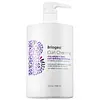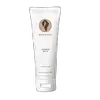What's inside
What's inside
 Key Ingredients
Key Ingredients

 Benefits
Benefits

 Concerns
Concerns

 Ingredients Side-by-side
Ingredients Side-by-side

Water
Skin ConditioningCetyl Alcohol
EmollientStearyl Alcohol
EmollientBrassica Alcohol
EmollientGlycerin
HumectantCetyl Esters
EmollientParfum
MaskingBehentrimonium Methosulfate
Caprylic/Capric Triglyceride
MaskingIsopropyl Palmitate
EmollientOryza Sativa Extract
AbsorbentButyrospermum Parkii Butter
Skin ConditioningKeratin Amino Acids
Skin ConditioningHelianthus Annuus Seed Oil
EmollientPrunus Amygdalus Dulcis Oil
Skin ConditioningLactobacillus/Tomato Fruit Ferment Extract
Skin ConditioningAcanthus Mollis Leaf Extract
Skin ConditioningBambusa Vulgaris Extract
Skin ConditioningCitrus Aurantium Dulcis Fruit Extract
MaskingCitrus Aurantium Dulcis Peel Oil
MaskingCitrus Paradisi Peel Oil
MaskingRosa Canina Fruit Oil
EmollientTocopheryl Acetate
AntioxidantPanthenol
Skin ConditioningAloe Barbadensis Leaf Juice
Skin ConditioningSaccharina Longicruris Extract
HumectantAcyl Coenzyme A Desaturase
Skin ConditioningOcimum Basilicum Leaf Extract
Skin ConditioningCetrimonium Chloride
AntimicrobialIsododecane
EmollientGuar Hydroxypropyltrimonium Chloride
Skin ConditioningLeuconostoc/Radish Root Ferment Filtrate
AntimicrobialButylene Glycol
HumectantCitric Acid
BufferingBrassicyl Isoleucinate Esylate
Emulsion StabilisingDehydroacetic Acid
PreservativeBenzyl Alcohol
PerfumingWater, Cetyl Alcohol, Stearyl Alcohol, Brassica Alcohol, Glycerin, Cetyl Esters, Parfum, Behentrimonium Methosulfate, Caprylic/Capric Triglyceride, Isopropyl Palmitate, Oryza Sativa Extract, Butyrospermum Parkii Butter, Keratin Amino Acids, Helianthus Annuus Seed Oil, Prunus Amygdalus Dulcis Oil, Lactobacillus/Tomato Fruit Ferment Extract, Acanthus Mollis Leaf Extract, Bambusa Vulgaris Extract, Citrus Aurantium Dulcis Fruit Extract, Citrus Aurantium Dulcis Peel Oil, Citrus Paradisi Peel Oil, Rosa Canina Fruit Oil, Tocopheryl Acetate, Panthenol, Aloe Barbadensis Leaf Juice, Saccharina Longicruris Extract, Acyl Coenzyme A Desaturase, Ocimum Basilicum Leaf Extract, Cetrimonium Chloride, Isododecane, Guar Hydroxypropyltrimonium Chloride, Leuconostoc/Radish Root Ferment Filtrate, Butylene Glycol, Citric Acid, Brassicyl Isoleucinate Esylate, Dehydroacetic Acid, Benzyl Alcohol
Water
Skin ConditioningHelianthus Annuus Seed Oil
EmollientGlycerin
HumectantRicinus Communis Seed Oil
MaskingCetyl Alcohol
EmollientButyrospermum Parkii Butter
Skin ConditioningAloe Barbadensis Leaf Juice
Skin ConditioningGlyceryl Stearate
EmollientSorbitan Stearate
EmulsifyingBiotin
AntiseborrhoeicCetearyl Glucoside
EmulsifyingStearyl Alcohol
EmollientAdansonia Digitata Seed Oil
EmollientAstrocaryum Murumuru Seed Butter
EmollientMangifera Indica Seed Butter
Skin ConditioningBrassica Oleracea Italica Seed Oil
EmollientHydroxyethylcellulose
Emulsion StabilisingNigella Sativa Seed Oil
EmollientCrambe Abyssinica Seed Oil
Skin ConditioningOlea Europaea Fruit Oil
MaskingArgania Spinosa Kernel Oil
EmollientTrigonella Foenum-Graecum Seed Extract
PerfumingRosa Centifolia Flower Oil
MaskingCitrus Aurantium Amara Peel Oil
Skin ConditioningTocopheryl Acetate
AntioxidantAscorbic Acid
AntioxidantXanthan Gum
EmulsifyingUndecylenoyl Glycine
CleansingCapryloyl Glycine
CleansingCaprylyl Glycol
EmollientEthylhexylglycerin
Skin ConditioningParfum
MaskingWater, Helianthus Annuus Seed Oil, Glycerin, Ricinus Communis Seed Oil, Cetyl Alcohol, Butyrospermum Parkii Butter, Aloe Barbadensis Leaf Juice, Glyceryl Stearate, Sorbitan Stearate, Biotin, Cetearyl Glucoside, Stearyl Alcohol, Adansonia Digitata Seed Oil, Astrocaryum Murumuru Seed Butter, Mangifera Indica Seed Butter, Brassica Oleracea Italica Seed Oil, Hydroxyethylcellulose, Nigella Sativa Seed Oil, Crambe Abyssinica Seed Oil, Olea Europaea Fruit Oil, Argania Spinosa Kernel Oil, Trigonella Foenum-Graecum Seed Extract, Rosa Centifolia Flower Oil, Citrus Aurantium Amara Peel Oil, Tocopheryl Acetate, Ascorbic Acid, Xanthan Gum, Undecylenoyl Glycine, Capryloyl Glycine, Caprylyl Glycol, Ethylhexylglycerin, Parfum
Ingredients Explained
These ingredients are found in both products.
Ingredients higher up in an ingredient list are typically present in a larger amount.
Aloe Barbadensis Leaf Juice comes from leaves of the aloe plant. Aloe Barbadensis Leaf Juice is best known for helping to soothe sunburns. It is also anti-inflammatory, moisturizing, antiseptic, and can help heal wounds.
Aloe is packed with good stuff including Vitamins A, C, and E. These vitamins are antioxidants, which help fight free-radicals and the damage they may cause. Free-radicals are molecules that may damage your skin cells, such as pollution.
Aloe Barbadensis Leaf Juice also contains sugars. These sugars come in the form of monosaccharides and polysaccharides, folic acid, and choline. These sugars are able to help bind moisture to skin.
It also contains minerals such as calcium, 12 anthraquinones, fatty acids, amino acids, and Vitamin B12.
Learn more about Aloe Barbadensis Leaf JuiceThis ingredient is also known as shea butter. It is an effective skin hydrator and emollient.
Emollients help soothe and soften your skin. It does this by creating a protective film on your skin. This barrier helps trap moisture and keeps your skin hydrated. Emollients may be effective at treating dry or itchy skin.
Shea butter is rich in antioxidants. Antioxidants help fight free-radicals, or molecules that may harm the body. It is also full of fatty acids including stearic acid and linoleic acid. These acids help replenish the skin and keep skin moisturized.
While Shea Butter has an SPF rating of about 3-4, it is not a sunscreen replacement.
Shea butter may not be fungal acne safe. We recommend speaking with a professional if you have any concerns.
Learn more about Butyrospermum Parkii ButterCetyl Alcohol is a fatty alcohol. Fatty Alcohols are most often used as an emollient or to thicken a product.
Its main roles are:
Though it has "alcohol" in the name, it is not related to denatured alcohol or ethyl alcohol.
The FDA allows products labeled "alcohol-free" to have fatty alcohols.
Learn more about Cetyl AlcoholGlycerin is already naturally found in your skin. It helps moisturize and protect your skin.
A study from 2016 found glycerin to be more effective as a humectant than AHAs and hyaluronic acid.
As a humectant, it helps the skin stay hydrated by pulling moisture to your skin. The low molecular weight of glycerin allows it to pull moisture into the deeper layers of your skin.
Hydrated skin improves your skin barrier; Your skin barrier helps protect against irritants and bacteria.
Glycerin has also been found to have antimicrobial and antiviral properties. Due to these properties, glycerin is often used in wound and burn treatments.
In cosmetics, glycerin is usually derived from plants such as soybean or palm. However, it can also be sourced from animals, such as tallow or animal fat.
This ingredient is organic, colorless, odorless, and non-toxic.
Glycerin is the name for this ingredient in American English. British English uses Glycerol/Glycerine.
Learn more about GlycerinHelianthus Annuus Seed Oil is the oil derived from the seeds of a Sunflower. Sunflower seed oil is non-fragrant. It is an emollient, meaning it helps to soften the skin.
Sunflower seed oil contains many fatty acids. The fatty acids found in sunflower seeds include (from highest amount to least): linoleic acid, myristic acid, palmitic acid, stearic acid, arachidic acid, oleic acid, and linolenic acid.
These fatty acids help the skin create ceramides. Ceramides play a role in repairing the skin barrier.
Helianthus Annuus Seed Oil helps moisturize the skin. This in turn helps the skin look more rejuvenated and smoother.
Sunflowers are rich in vitamin E.
Historians believe Indigenous cultures of North America domesticated sunflowers before corn. Thus they relied on sunflower oil for a variety of uses. One such use is moisturizing skin and hair.
Sunflower seed oil may not be fungal acne safe. We recommend speaking with a professional if you have any concerns.
Learn more about Helianthus Annuus Seed OilParfum is a catch-all term for an ingredient or more that is used to give a scent to products.
Also called "fragrance", this ingredient can be a blend of hundreds of chemicals or plant oils. This means every product with "fragrance" or "parfum" in the ingredients list is a different mixture.
For instance, Habanolide is a proprietary trade name for a specific aroma chemical. When used as a fragrance ingredient in cosmetics, most aroma chemicals fall under the broad labeling category of “FRAGRANCE” or “PARFUM” according to EU and US regulations.
The term 'parfum' or 'fragrance' is not regulated in many countries. In many cases, it is up to the brand to define this term.
For instance, many brands choose to label themselves as "fragrance-free" because they are not using synthetic fragrances. However, their products may still contain ingredients such as essential oils that are considered a fragrance by INCI standards.
One example is Calendula flower extract. Calendula is an essential oil that still imparts a scent or 'fragrance'.
Depending on the blend, the ingredients in the mixture can cause allergies and sensitivities on the skin. Some ingredients that are known EU allergens include linalool and citronellol.
Parfum can also be used to mask or cover an unpleasant scent.
The bottom line is: not all fragrances/parfum/ingredients are created equally. If you are worried about fragrances, we recommend taking a closer look at an ingredient. And of course, we always recommend speaking with a professional.
Learn more about ParfumStearyl Alcohol is a type of fatty alcohol from stearic acid. It is a white, waxy compound used to emulsify ingredients.
Fatty Alcohols are most often used as an emollient or to thicken a product. Emollients help soothe and hydrate the skin by trapping moisture.
They are usually derived from natural fats and oils and therefore do not have the same drying or irritating effect as solvent alcohols. FDA allows products labeled "alcohol-free" to have fatty alcohols.
Learn more about Stearyl AlcoholTocopheryl Acetate is AKA Vitamin E. It is an antioxidant and protects your skin from free radicals. Free radicals damage the skin by breaking down collagen.
One study found using Tocopheryl Acetate with Vitamin C decreased the number of sunburned cells.
Tocopheryl Acetate is commonly found in both skincare and dietary supplements.
Learn more about Tocopheryl AcetateWater. It's the most common cosmetic ingredient of all. You'll usually see it at the top of ingredient lists, meaning that it makes up the largest part of the product.
So why is it so popular? Water most often acts as a solvent - this means that it helps dissolve other ingredients into the formulation.
You'll also recognize water as that liquid we all need to stay alive. If you see this, drink a glass of water. Stay hydrated!
Learn more about Water